Zoom
Trash

Little Rock High School REGULAR. The USA, 1945 - 1975.
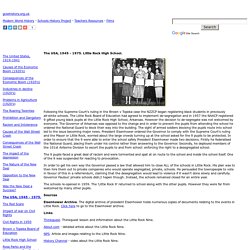
Little Rock High School. Following the Supreme Court's ruling in the Brown v Topeka case the NZZCP began registering black students in previously all-white schools. The Little Rock Board of Education had agreed to implement de-segregation and in 1957 the NAACP registered 9 gifted young black pupils at the Little Rock High School, Arkansas. However the decision to de-segregate was not welcomed by everyone. The Governor of Arkansas was opposed to the change and in order to prevent the pupils from attending the school he ordered the National Guard to block their way into the building.
The 9 pupils faced a great deal of racism and were tormented and spat at on route to the school and inside the school itself. In order to get his own way the Governor passed a law that allowed him to close ALL of the schools in Little Rock. The schools re-opened in 1959. Sources Eisenhower Archive. Links. Little Rock High School REGULAR. Little Rock High School MEDIUM. 1957: Troops end Little Rock school crisis Nine black children have finally been able to attend Central High School in Little Rock, Arkansas.
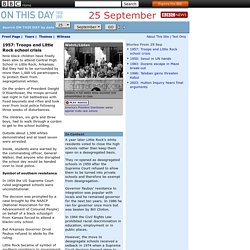
But they had to be surrounded by more than 1,000 US paratroopers to protect them from segregationist whites. On the orders of President Dwight D Eisenhower, the troops arrived last night in full battledress with fixed bayonets and rifles and took over from local police following three weeks of disturbances. The children, six girls and three boys, had to walk through a cordon to get to the school building. Outside about 1,500 whites demonstrated and at least seven were arrested. Inside, students were warned by the commanding officer, General Walker, that anyone who disrupted the school day would be handed over to local police. Little Rock School 1957 MEDIUM. Three years after the U.S.
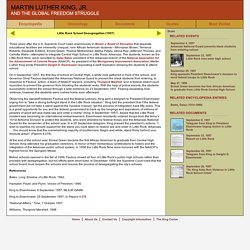
Supreme Court ruled unanimously in Brown v. Board of Education that separate educational facilities are inherently unequal, nine African American students—Minnijean Brown, Terrance Roberts, Elizabeth Eckford, Ernest Green, Thelma Mothershed, Melba Patillo, Gloria Ray, Jefferson Thomas, and Carlotta Walls—attempted to integrate Central High School in Little Rock, Arkansas.
The students, known as the Little Rock Nine, were recruited by Daisy Bates, president of the Arkansas branch of the National Association for the Advancement of Colored People (NAACP). As president of the Montgomery Improvement Association, Martin Luther King wrote President Dwight D. Eisenhower requesting a swift resolution allowing the students to attend school. Little Rock High School CHALLENGING. Central High In September of 1957, the country was changed forever by the “Crisis at Central High”—one of the first federally ordered integration acts.
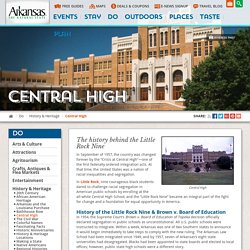
At that time, the United States was a nation of racial inequalities and segregation. In Little Rock, nine courageous black students dared to challenge racial segregation in American public schools by enrolling at the all-white Central High School, and the “Little Rock Nine” became an integral part of the fight for change and a foundation for equal opportunity in America. Martin Luther King homework - illustrated timeline. Martin Luther King timeline REGULAR. Martin Luther King, Jr.
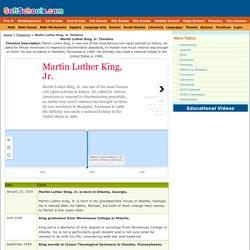
TimelineTimeline Description: Martin Luther King, Jr. was one of the most famous civil rights activists in history. He called for African Americans to respond to discrimination peacefully, no matter how much violence was brought on them. Martin Luther King timeline CHALLENGING. Martin Luther King Jr. was a Baptist minister and social activist, who led the Civil Rights Movement in the United States from the mid-1950s until his death by assassination in 1968.
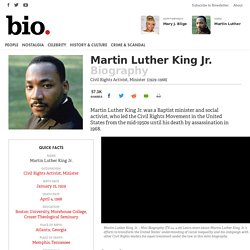
Montgomery Bus Boycott 1. Montgomery Bus Boycott 2. 5.4 Birmingham Alabama outline. 5.4 March on Washington outline. The Birmingham Campaign - start here & watch video. In the spring of 1963, activists in Birmingham, Alabama launched one of the most influential campaigns of the Civil Rights Movement: Project C, better known as The Birmingham Campaign.
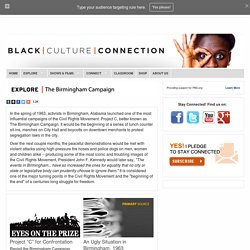
It would be the beginning of a series of lunch counter sit-ins, marches on City Hall and boycotts on downtown merchants to protest segregation laws in the city. Over the next couple months, the peaceful demonstrations would be met with violent attacks using high-pressure fire hoses and police dogs on men, women and children alike -- producing some of the most iconic and troubling images of the Civil Rights Movement.
President John F. Kennedy would later say, "The events in Birmingham... have so increased the cries for equality that no city or state or legislative body can prudently choose to ignore them. " Fact sheet Birmingham, Alabama 1963. Birmingham campaign 1963. In April 1963 Martin Luther King went to Birmingham, Alabama, a city where public facilities were separated for blacks and whites.
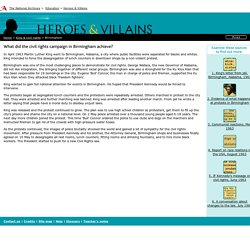
King intended to force the desegregation of lunch counters in downtown shops by a non-violent protest. Birmingham 1963. In 1963, Birmingham became a focus for the civil rights movement.
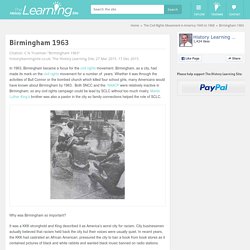
Birmingham, as a city, had made its mark on the civil rights movement for a number of years. Whether it was through the activities of Bull Connor or the bombed church which killed four school girls, many Americans would have known about Birmingham by 1963. Both SNCC and the NAACP were relatively inactive in Birmingham; so any civil rights campaign could be lead by SCLC without too much rivalry. Martin Luther King’s brother was also a pastor in the city so family connections helped the role of SCLC. Why was Birmingham so important? March on Washington - start here and watch video. As blacks faced continuing discrimination in the postwar years, the March on Washington group met annually to reiterate blacks’ demands for economic equality.
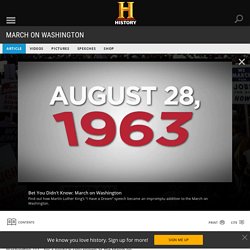
The civil rights movement of the 1960s transformed the political climate, and in 1963, black leaders began to plan a new March on Washington, designed specifically to advocate passage of the Civil Rights Act then stalled in Congress. Chaired again by A. Philip Randolph and organized by his longtime associate, Bayard Rustin, this new March for Jobs and Freedom was expected to attract 100,000 participants. President John F. Kennedy showed as little enthusiasm for the march as had Roosevelt, but this time the black leaders would not be dissuaded. Factsheet the March on Washington. Civil Rights March on Washington (History, Facts, Martin Luther King Jr.)
By Shmuel Ross The March on Washington for Jobs and Freedom took place in Washington, D.C., on August 28, 1963. Attended by some 250,000 people, it was the largest demonstration ever seen in the nation's capital, and one of the first to have extensive television coverage. Background 1963 was noted for racial unrest and civil rights demonstrations. Nationwide outrage was sparked by media coverage of police actions in Birmingham, Alabama, where attack dogs and fire hoses were turned against protestors, many of whom were in their early teens or younger.
Coalition The March on Washington represented a coalition of several civil rights organizations, all of which generally had different approaches and different agendas. Opposition President Kennedy originally discouraged the march, for fear that it might make the legislature vote against civil rights laws in reaction to a perceived threat. March on Washington for Jobs and Freedom. On 28 August 1963, more than 200,000 demonstrators took part in the March on Washington for Jobs and Freedom in the nation’s capital. The march was successful in pressuring the administration of John F. Kennedy to initiate a strong federal civil rights bill in Congress. During this event, Martin Luther King delivered his memorable ‘‘I Have a Dream’’ speech. 9LGreensboro and Freedom Rides homework. 9L homework - sit ins and freedom rides photographs.